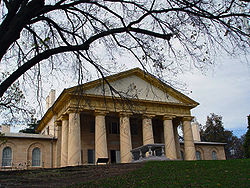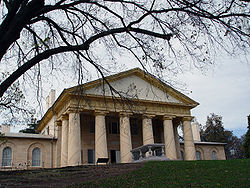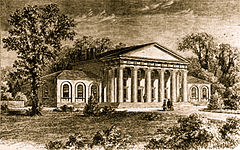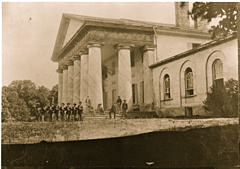Arlington House

American Artifacts: Arlington House
 Arlington House, The Robert E. Lee Memorial
Arlington House, The Robert E. Lee Memorial
Arlington House, The Robert E. Lee Memorial, formerly named the Custis-Lee Mansion, is a Greek revival style mansion located in Arlington, Virginia, USA that was once the home of Confederate General Robert E. Lee. It overlooks the Potomac River and the National Mall in Washington, D.C. During the American Civil War, the grounds of the mansion were selected as the site of Arlington National Cemetery, in part to ensure that Lee would never again be able to return to his home. However, the United States has since designated the mansion as a National Memorial to Lee, a mark of widespread respect for him in both the North and South. Arlington Woods, located behind Arlington House, contains the oldest and largest tract of climax eastern hardwood forest that still exists in Arlington County.
Construction and Early History
 Arlington House from a pre-1861 sketch, published in 1875
Arlington House from a pre-1861 sketch, published in 1875
The mansion was built on the orders of George Washington Parke Custis, the step-grandson and adopted son of George Washington and only grandson of Martha Custis Washington. Custis was a prominent resident of what was then known as Alexandria County, at the time a part of the District of Columbia.
Arlington House was built at a high point on an 1,100 acre (445 ha) estate that Custis’ father, John Parke Custis, had purchased in 1778. (“Jacky” Custis died in 1781 at Yorktown after the British surrender.) George Washington Parke Custis decided to build his home on the property in 1802, following the death of Martha Washington and three years after the death of George Washington. Custis originally wanted to name the property “Mount Washington,” but was persuaded by family members to name it “Arlington House” after the Custis family’s homestead on the Eastern Shore of Virginia.
George Hadfield, an English architect who also worked on the design of the United States Capitol, designed the mansion. Construction began eleven years after L’Enfant’s Plan for the future “Federal City” (later called “Washington City,” then Washington D.C.) had designated an area directly across the Potomac River to be the site of the “President’s House” (later called the “Executive Mansion”, now the White House) and the “Congress House” (now the United States Capitol).
The north and south wings were completed in 1804. The large center section and the portico, presenting an imposing front 140 ft (43 m) long, were finished 13 years later. The house has two kitchens, a summer and a winter. The most prominent features of the house are the 8 massive columns of the portico, each 5 feet (1.5 m) in diameter.
Custis was a prominent resident of the jurisdiction that was then named Alexandria County and is now named Arlington County. Guests at the house included such notable people as Gilbert du Motier, Marquis de Lafayette, who visited in 1824 (see: Visit of the Marquis de Lafayette to the United States). At Arlington, Custis experimented with new methods of animal husbandry and other agriculture. The property also included Arlington Spring, a picnic ground on the banks of the Potomac that Custis originally built for private use but later opened to the public, eventually operating it as a commercial enterprise.
Custis married Mary Lee Fitzhugh. Their only child to survive to adulthood was Mary Anna Randolph Custis. Robert E. Lee, whose mother was a cousin of Mrs. Custis, frequently visited Arlington and knew Mary Anna as they grew up. Two years after graduating from West Point, Lieutenant Lee married Mary Anna Custis at Arlington on June 30, 1831. For 30 years Arlington House was home to the Lees. They spent much of their married life traveling between U.S. Army duty stations and Arlington, where six of their seven children were born. They shared this home with Mary’s parents. After their deaths, Mary’s parents were buried not far from the house on land that is now part of Arlington National Cemetery.
The Custises extensively developed the Arlington estate. Much of the steep slope to the east of the house became a cultivated English landscape park, while a large flower garden with an arbor was constructed and planted south of the house. To the west of Arlington House, tall grass and low native plants led down a slope into a natural area of close-growing trees the Custises called “the Grove.” About 60 feet (18 m) to the west of the flower garden, “the Grove” contained tall elm and oak trees which formed a canopy. An informal flower garden was planted beneath the trees and maintained by the Custis daughters. It is not clear when “the Grove” began to be developed, but it was under way by at least 1853
Upon George Washington Parke Custis’ death in 1857, he left the Arlington estate to Mary Custis Lee for her lifetime and thence to the Lees’ eldest son, George Washington Custis Lee. The estate needed much repair and reorganization, and Robert E. Lee, as executor of Custis’ will, took a three-year leave of absence from the Army to begin the necessary agricultural and financial improvements. The will also required the executor to free the slaves on the estate within five years of Custis’ death. Robert E. Lee fulfilled this requirement by manumitting the slaves in December 1862.
Civil War
 East front of Custis-Lee Mansion with Union Soldiers on lawn
East front of Custis-Lee Mansion with Union Soldiers on lawn
In April 1861, Virginia seceded from the United States. Robert E. Lee resigned his commission in the United States Army on April 20, 1861, and joined the military forces of the Confederate States of America. With Arlington House on high ground overlooking the capital, the government of the United States knew it must occupy the mansion or be left in an untenable military position. Although unwilling to leave Arlington House, Mary Lee believed her estate would soon be infested with federal soldiers and left to stay with relatives on May 14. Union troops occupied Arlington without opposition on May 24.
In June 1862, the U.S. Congress enacted legislation which imposed a property tax on all land in “insurrectionary” areas of the United States. The 1863 amendments to the statute required these taxes to be paid in person. But Mary Lee, afflicted with severe rheumatoid arthritis and behind Confederate lines, could not pay the tax in person. The Arlington estate was seized for nonpayment of taxes. It was auctioned off on January 11, 1864, and the U.S. government won the property for $26,800 ($412,895 in 2014 dollars).
During the war, Union troops cut down many of the trees on the Arlington estate, especially those to the north and east of Arlington House in and near Fort Whipple (north of the house) and Arlington Springs (near the Potomac River). However, a number of large trees remained, particularly those in a forested area (now known as Arlington Woods) west of the house.
By early 1864, the military cemeteries of Washington, D.C., and Alexandria, Virginia, were rapidly filling with war dead. Quartermaster General of the United States Army Montgomery C. Meigs proposed using 200 acres (81 ha) of the Arlington estate as a cemetery. United States Secretary of War Edwin M. Stanton approved the establishment of a military cemetery on June 15, 1864, creating Arlington National Cemetery. Meigs believed Lee committed treason in deciding to fight against the Union, and denying Lee use of the mansion after the war was politically advantageous. Meigs decided that a large number of burials should occur close to Arlington House to render it unlivable. Officers were to be buried next to the main flower garden south of the hourse, and the first burial occurred here on May 17. Meigs ordered that additional burials commence immediately on the grounds of Arlington House in mid-June. When Union officers bivouacked in the mansion complained and had the burials temporarily stopped, Meigs countermanded their orders and had another 44 dead officers buried along the southern and eastern sides of the main flower garden within a month.
In September 1866, a memorial and a burial vault containing the remains of 2,111 Union and Confederate soldiers who died at the First Battle of Bull Run, Second Battle of Bull Run, and along the Rappahannock River were buried on the former site of “the Grove” southeast of the mansion beneath the Civil War Unknowns Monument.
http://en.wikipedia.org/wiki/Arlington_House,_The_Robert_E._Lee_Memorial

